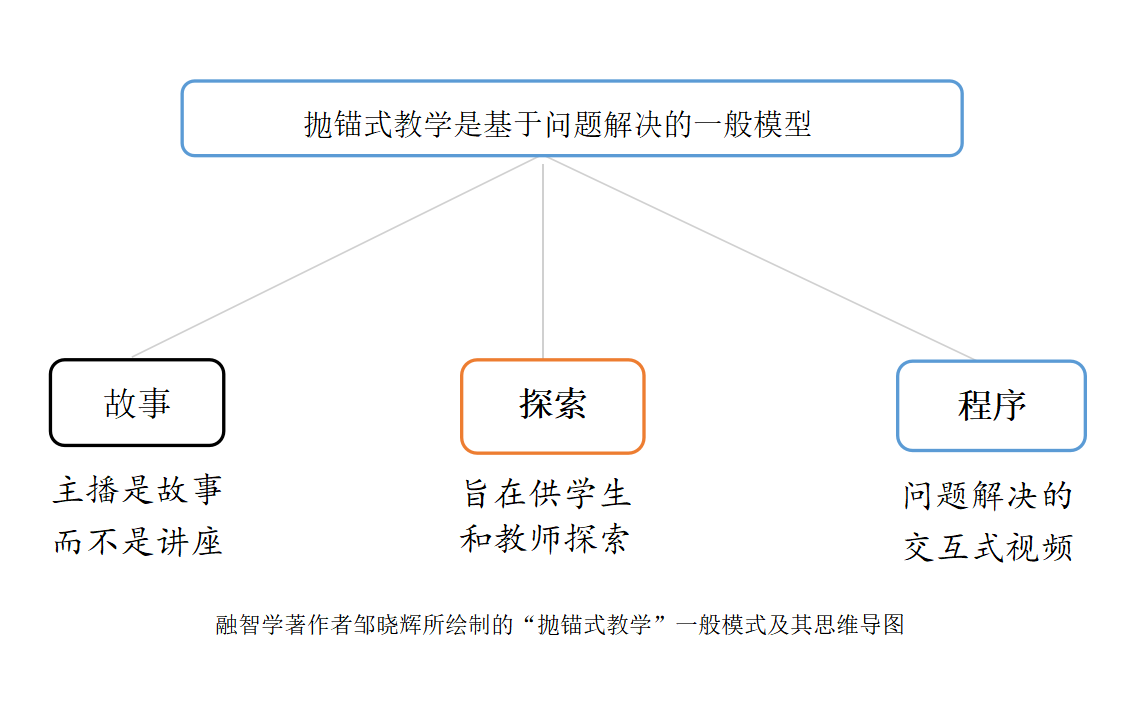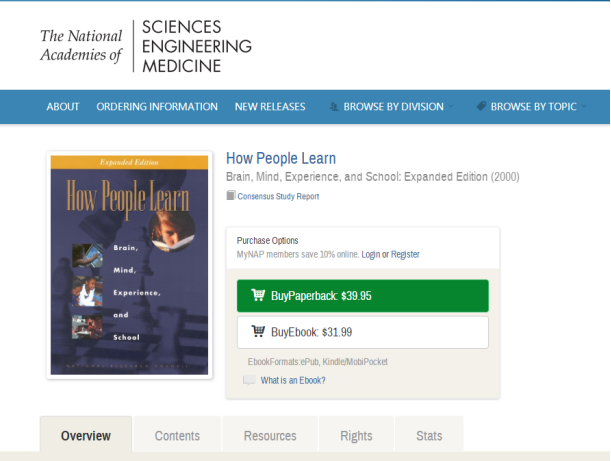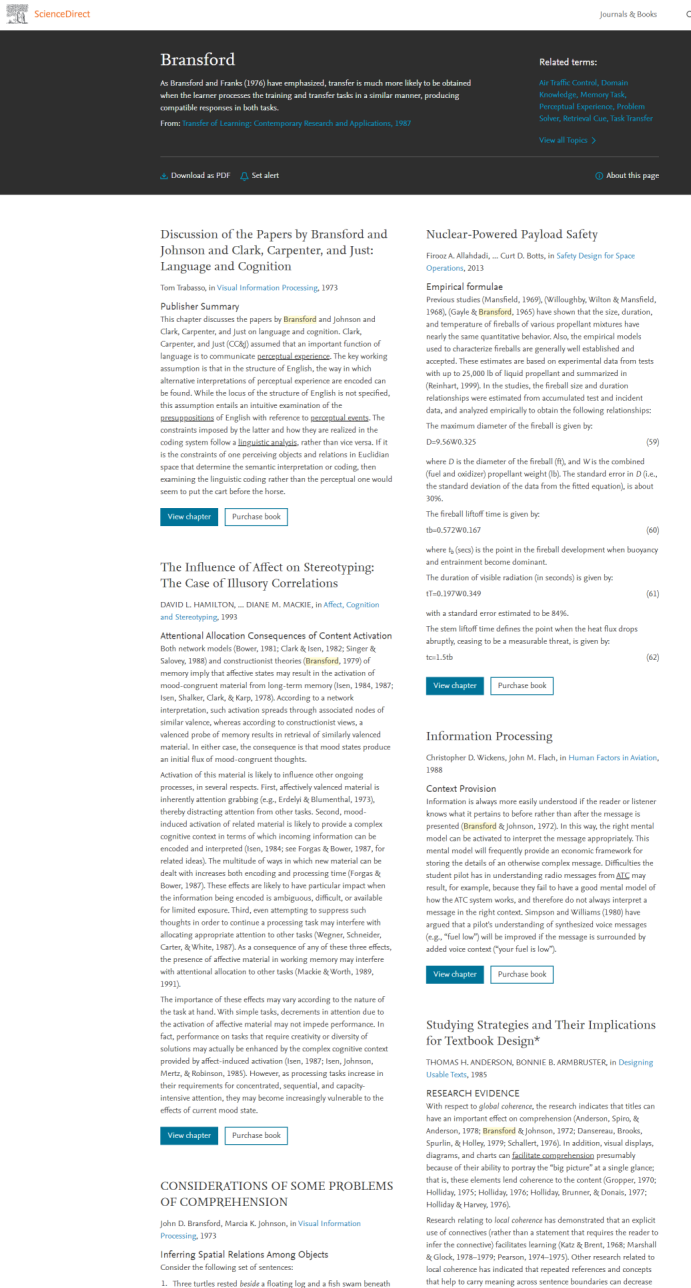博文
学习理论54-5:抛锚式教学(zxh双语文本分析)
||
一、引言
富文本分析及相应的专家研究工作过程的一系列信息处理方法,是本研究特别关注的研究方法。
如何锚定知识海洋里畅游的一艘一艘的航船?怎样由此抓住一个一个目标域的学术带头人的研究思路及其整个背景知识体系?这是本研究关注的一个焦点。
二、图文结合展示
常言道,一幅图胜过千言万语。尤其是深思熟虑的思维导图,更是如此。不信各位读者可以自己试一试,看各自如何把刚学的这些双语文本表达的知识内容,简化成为一目了然的思维导图。
图1 基于技术的学习的主要范式
由图1可见,所谓“抛锚式教学”所抛出的“锚”可视为在知识海洋里畅游的教学双方共同的“宏观背景”。它是基于计算机网络数据技术支持的自主学习,打算积极建构的知识目标域是在有趣的和现实的上下文环境里面可由教学双方自主确定的。实际应用的举例范围首先是初级阅读、语言艺术和数学技能等通用知识通用技能。

图2 基于解决问题的一般模型
由图2可见,所谓“抛锚式教学”所述的“一般模型”是主播的故事(“锚”)在基于问题解决的交互式视频(“宏观背景”)即易于操作的程序辅助之下,供教学双方做积极探索的直到模型。试想:师生们在相对确定的知识海域畅游这样的情境,就好理解我们的探索历程所向往的港湾或海域及其所需要的“锚”定点。

图3 《人们如何学习:大脑、思维、经验和学校》的封面及其相关背景
由图3可见,抛锚式教学的领军人物约翰·布朗斯福德,也是《人们如何学习:大脑、思维、经验和学校》第一作者。这个“锚”可抛的范围就大了!

图4 《人们如何学习:大脑、思维、经验和学校》的插图及其相关内容
由图4可见,抛锚式教学领军人物和《人们如何学习:大脑、思维、经验和学校》第一作者约翰·布朗斯福德给我们展示了什么样的“宏观背景”及其可支撑其“锚”理论的“主要范式”和“一般模型”。

图5 围绕“布朗斯福德”及其研究群体和同行究竟在做什么
由图5可见,布朗斯福德及其研究群体和同行们从20世纪下半世纪就已经做了大量的研究。直到最近,学习者的背景知识才被认为与知识转移有关。也许这种忽视是由于研究人员在类别学习和问题解决任务中过度使用了人工材料,而这些材料几乎没有相关的先验知识。最近的工作利用了更多的自然材料;因此,先验知识的作用已经成为一个更核心的问题。
三、双语文本分析
抛锚式教学(约翰·布朗斯福德) Anchored Instruction (John Bransford)
抛锚式教学是一种基于技术的学习的主要范式,由范德比尔特大学(CTGV)的认知与技术小组在约翰·布朗斯福德的领导下开发。
Anchored instruction is a major paradigm for technology-based learning that has been developed by the Cognition & Technology Group at Vanderbilt (CTGV) under the leadership of John Bransford.
虽然许多人都对抛锚式教学的理论和研究做出了贡献,但布兰斯福德是主要发言人,因此该理论应归功于他。
While many people have contributed to the theory and research of anchored instruction, Bransford is the principal spokesperson and hence the theory is attributed to him.
这项工作的最初重点是开发交互式视频光盘工具,鼓励学生和教师提出并解决复杂的现实问题。
The initial focus of the work was on the development of interactive videodisc tools that encouraged students and teachers to pose and solve complex, realistic problems.
视频材料是所有后续学习和教学的“锚”(宏观背景)。
The video materials serve as “anchors” (macro-contexts) for all subsequent learning and instruction.
正如CTGV (1993年,第52页)所解释的:“这些主播的设计与通常用于教育的视频设计截然不同……我们的目标是创造有趣、现实的上下文环境,鼓励学习者积极构建知识。
As explained by CTGV (1993, p52): “The design of these anchors was quite different from the design of videos that were typically used in education…our goal was to create interesting, realistic contexts that encouraged the active construction of knowledge by learners.
我们的主播是故事而不是讲座,旨在供学生和教师探索。”
Our anchors were stories rather than lectures and were designed to be explored by students and teachers. ”
交互式视盘技术的使用使学生能够轻松地探索内容。The use of interactive videodisc technology makes it possible for students to easily explore the content.
抛锚式教学与情境学习框架(见CTGV,1990年,1993年)以及认知灵活性理论它强调利用技术为基础的学习。
Anchored instruction is closely related to the situated learning framework (see CTGV, 1990, 1993) and also to the Cognitive Flexibility Theory in its emphasis on the use of technology-based learning.
应用 Application
抛锚式教学的主要应用是初级阅读、语言艺术和数学技能。
The primary application of anchored instruction has been to elementary reading, language arts and mathematics skills.
CLGV开发了一套名为“Jasper Woodbury问题解决系列”的交互式视频光盘程序。
The CLGV has developed a set of interactive videodisc programs called the “Jasper Woodbury Problem Solving Series”.
这些项目包括利用数学概念解决问题的冒险。
These programs involve adventures in which mathematical concepts are used to solve problems .
然而,抛锚式教学范式是基于问题解决的一般模型(Bransford & Stein,1993)。
However, the anchored instruction paradigm is based upon a general model of problem-solving (Bransford & Stein, 1993).
例子 Example
早期的抛锚式教学活动之一是以互动视频光盘的形式使用电影《少年福尔摩斯》。
One of the early anchored instruction activities involved the use of the film, “Young Sherlock Holmes” in interactive videodisc form.
学生们被要求从因果关系、人物动机和背景真实性的角度来审视这部电影,以了解维多利亚时代英格兰生活的本质。
Students were asked to examine the film in terms of causal connections, motives of the characters, and authenticity of the settings in order to understand the nature of life in Victorian England.
这部电影为理解讲故事和一个特定的历史时代提供了依据。
The film provides the anchor for an understanding of story-telling and a particular historical era.
原则 Principles
学习和教学活动应该围绕一个“锚”来设计,这个“锚”应该是某种案例研究或问题情境。
Learning and teaching activities should be designed around a “anchor” which should be some sort of case-study or problem situation.
课程材料应允许学习者探索(例如,交互式视频光盘节目)。
Curriculum materials should allow exploration by the learner (e.g., interactive videodisc programs).
有关锚定教学的更多信息,请访问网站斯福特或者贾斯珀·伍德伯里项目在范德比尔特大学。
For more about anchored instruction, visit the web site of John Bransford or the Jasper Woodbury project at Vanderbilt University.
参考 References
布朗斯福德等人(1990年).抛锚式教学:为什么我们需要它,技术如何帮助.在D. Nix & R. Sprio (Eds)一案中,认知、教育和多媒体.新泽西州希尔斯代尔:厄尔鲍姆协会
Bransford, J.D. et al. (1990). Anchored instruction: Why we need it and how technology can help. In D. Nix & R. Sprio (Eds), Cognition, education and multimedia. Hillsdale, NJ: Erlbaum Associates.
布朗斯福德,法学博士和斯坦,理学学士(1993年)。理想的问题解决者(第二版)。纽约:弗里曼。
Bransford, J.D. & Stein, B.S. (1993). The Ideal Problem Solver (2nd Ed). New York: Freeman.
CTGV (1990年)。抛锚式教学及其与情境认知的关系.教育研究e规则第19 (6)条第2至10段。
CTGV (1990). Anchored instruction and its relationship to situated cognition. Educational Researcher, 19 (6), 2-10.
CTGV (1993年)。抛锚式教学与情境认知。教育技术, 33 (3), 52- 70.
CTGV (1993). Anchored instruction and situated cognition revisted. Educational Technology
四、结语
以上仅仅只是抛砖引玉地列举了一个典型示例。今天,我发现,以往的学习理论与现在的学习实践以及进一步的学习理论研究之间存在着千丝万缕的联系。虽然这种联系不为常人所注意,但是,它们的的确确存在。这就是我对这54个学习理论为什么要一个一个地逐一做双语文本分析和专家知识挖掘两方面系统研究或探索的一个相当重要的原因。就拿当前我撰写的“学习理论54-5:抛锚式教学”这一篇英汉双语文本分析及其隐含的专家知识挖掘的过程来说吧,它看似不起眼,其实,里面却深藏着原创研究者及其背后的专家团队成员一系列非常了不起的研究成果(前面我撰写“学习理论54-1至4”的每一篇也都有类似的情形)。因此,从这一篇开始,我不仅会把我的学习理解和心得体会做成思维导图在此分享,而且还会进一步深挖每一篇背后的专家知识成果及其值得我们继续做智慧融通融合的大跨界研究的素材。
https://wap.sciencenet.cn/blog-94143-1327291.html
上一篇:学习理论54-3:算法启发式理论(zxh双语文本分析)
下一篇:学习理论54-4:成人学习理论(zxh双语文本)